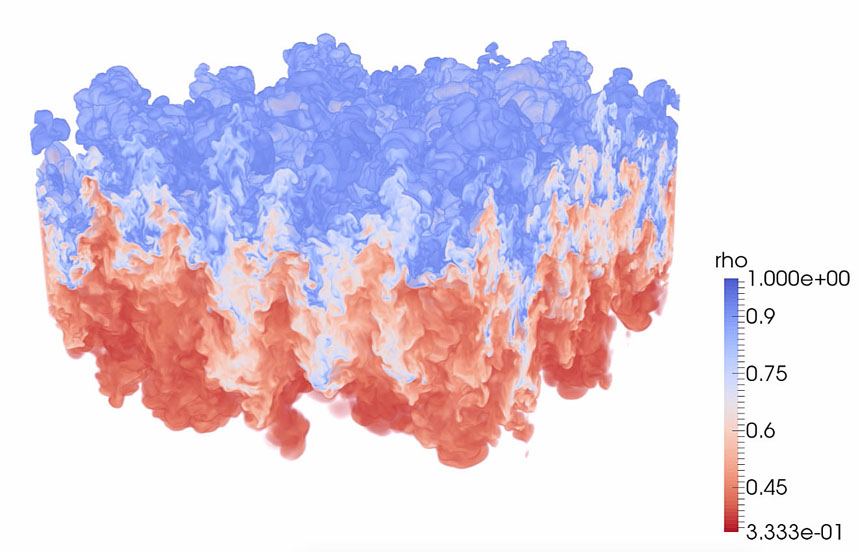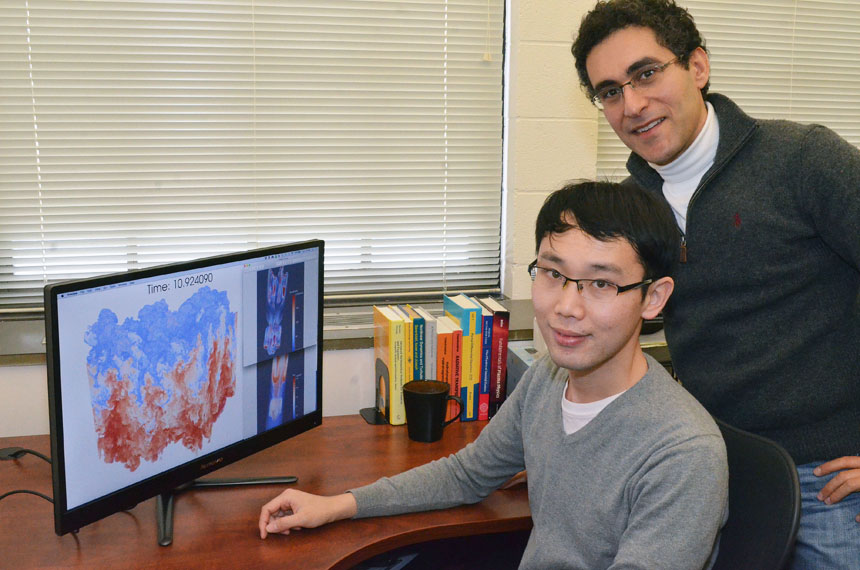Professor Aluie awarded 90 million additional hours of computer time to aid the quest for inertial confinement fusion

Fluid instabilities occur during inertial confinement fusion when the lasers turn the outer shell into a hot, low-density plasma that pushes against the colder, denser plasma inside, Professor Hussein Aluie explains. “It’s like having water over oil. The heavy part is on top and it’s unstable. It wants to sink, and the light fluid wants to rise.” As a result, “different materials start moving through each other, degrading the implosion"-- as shown in this image from one of the simulations Aluie and doctoral student Dongxiao Zhao created on the MIRA supercomputer, using a high-performance computing code they developed.
The concept of inertial confinement fusion seems simple enough. Concentrate enough laser energy to implode a spherical target of deuterium and tritium, and it should trigger a self-sustaining fusion reaction that could provide a virtually endless supply of clean energy.
However, despite years of progress at the University of Rochester’s Laboratory for Laser Energetics and other national labs, the barriers to achieving inertial confinement fusion remain daunting.
Among those barriers are the fluid instabilities that occur during implosion, preventing the fuel core from reaching high enough temperatures and densities.
Last year, Hussein Aluie, an assistant professor of mechanical engineering with expertise in fluid dynamics, was awarded a huge time chunk of time—47 million hours—on one of the world’s most powerful supercomputers to create detailed simulations of how those instabilities occur.
His results were so promising that the Department of Energy recently awarded Aluie an additional 90 million hours on the computer—Argonne National Laboratory’s MIRA supercomputer—to conduct additional simulations.
MIRA is rated in the top ten fastest supercomputers in the world, capable of carrying out 10 quadrillion calculations per second on its nearly 800,000 core processors. By comparison, the typical personal computer runs on two core processors.
Calling the instabilities “one of the primary hurdles to having inertial confinement fusion work,” Aluie says, “what we’re doing is looking at this process in an idealized setting—in isolation, without additional complexities that might, for the wrong reasons, give us the right answers. The goal is to understand the fundamental physics of this process.”
‘Like water over oil’
During inertial confinement fusion, lasers compress and heat a small spherical capsule of fusion fuel consisting of the hydrogen isotopes deuterium and tritium. When energy is applied to the exterior of the capsule, the capsule’s surface explodes outward, causing a reaction force on the inner portion of the capsule, which implodes. The implosion compresses and heats the interior fuel, which undergoes fusion and releases energy.
Fluid instabilities occur when the lasers turn the outer shell into a hot, low-density plasma that pushes against the colder, denser plasma inside, Aluie explains. “It’s like having water over oil. The heavy part is on top and it’s unstable. It wants to sink, and the light fluid wants to rise.” As a result, “different materials start moving through each other, degrading the implosion. It removes heat from the center, and brings in impurities from the outside. The target core doesn’t reach high enough temperatures and densities.”
With the first 47 million hours of access to MIRA, Aluie and his doctoral student Dongxiao Zhao used a high-performance computing code they developed to complete two controlled simulations of fluid instabilities, producing the highest resolution models achieved to date.
With the additional hours, Aluie and Zhao will factor in minute flaws on the target surface or slight variations in laser distribution that can contribute to fluid instabilities. “What we propose is to seed a controlled number of perturbations with specific wavelengths, so we can understand how they couple with each other, and grow at different rates,” Aluie says.
Once researchers have a better picture of what happens during fluid instabilities, Aluie says, they might find ways to overcome them.

Aluie, at right, and Zhao will use the additional hours on MIRA to factor in minute flaws on the target surface or slight variations in laser distribution that can contribute to fluid instabilities.
